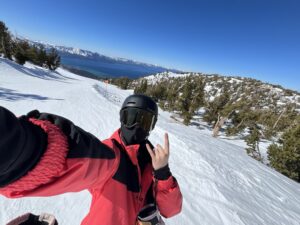Week 3: To the moon.. and maybe Disneyland!
Kira A -
Welcome back everyone! By the time you read this blog, I will likely be 10,000 ft above sea level snowboarding with the view of Lake Tahoe in front of me. (Ok, technically it’s behind me in this picture).

I am so incredibly thankful for this past week as it was filled with great memories I made with my friends and family: first in Disneyland and Knott’s Berry Farm and now in Lake Tahoe. The only thing left to do after all of that is go to the moon! But first, as I unfortunately do not have as much to report to you guys this week due to my travel, I have prepared a short video for you all explaining the orbital parameters (or elements) I will be using to define the orbit of my spacecraft throughout this mission. Below is the Youtube link so if you have the time, I would greatly appreciate it if you all could go and watch it!
This week, beyond covering the orbital parameters for my spacecraft, I wanted to look into the objectives for my mission. As stated before, my mission will be designed for freight transport to lunar orbit from orbit around Earth. However, I would like to outline some of the secondary objectives that this mission will aid in the completion of. The U.S. based Lunar Exploration Analysis Group (LEAG) revises and publishes the Lunar Exploration Roadmap (LER) each year to lay out many of the objectives for space agencies worldwide to follow and achieve as they explore the Moon and establish infrastructure on and around its surface. To organize these objectives, the LER has three main themes: the Science theme (Sci), the Feed Forward theme (FF), and the Sustainability theme (Sust). Among the many objectives outlined in the LER, my mission most closely aligns with the Sust objectives B-1, B-4, and B-6: “Implementation of comprehensive, coordinated integration of diverse scientific and exploration activities to maximize complementary operations and minimize operational and environmental conflicts,” “Establishment of sustainable transportation between Earth and the lunar surface,” and “Establishment of Global Communications and Navigation Capability,” respectively. In other words, my mission aims to facilitate further exploration and research on the Moon through creating an efficient mode of transportation between the Earth and the Moon and allowing streamlined communications within the cislunar region.
Looking towards next week, I plan to jump back into MATLAB to start modeling the orbit-raising maneuver so I can implement it into my final mission.
Thank you to all those who have been reading my blog since the beginning and to those who joined along the way! As always, a BIG thank you to Dr. Goodwin, Mr. Joseph, and Dr. Farooq for your generous support and guidance. I hope you will all join me again next week.
Ad Lunam!

Comments:
All viewpoints are welcome but profane, threatening, disrespectful, or harassing comments will not be tolerated and are subject to moderation up to, and including, full deletion.